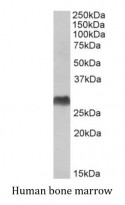ARG42174
anti-HLA DQA1 + HLA DQA2 antibody
anti-HLA DQA1 + HLA DQA2 antibody for Western blot and Human
Overview
| Product Description | Goat Polyclonal antibody recognizes HLA DQA1 + HLA DQA2 |
|---|---|
| Tested Reactivity | Hu |
| Tested Application | WB |
| Specificity | This antibody is expected to recognize: NP_064440.1 (HLA DQA2; GeneID: 3118) and also the very similar NP_002113.2 (HLA DQA1; GeneID:3117). |
| Host | Goat |
| Clonality | Polyclonal |
| Isotype | IgG |
| Target Name | HLA DQA1 + HLA DQA2 |
| Antigen Species | Human |
| Immunogen | Synthetic peptide around the C-terminus of Human HLA DQA1 / HLA DQA2. (C-QGLRSVGASRH) (NP_064440.1; NP_002113.2) |
| Conjugation | Un-conjugated |
| Alternate Names | HLA DQA1: HLA class II histocompatibility antigen, DQ alpha 1 chain; CELIAC1; HLA-DQA; MHC class II DQA1; CD; HLA-DCA; DC-alpha; GSE; DQ-A1; DC-1 alpha chain HLA DQA2: MHC class II DQA2; DX alpha chain; HLA class II histocompatibility antigen, DQ; HLA class II histocompatibility antigen, DQ alpha 2 chain; HLA-DXA; 6; HLA-DQA1; DX-ALPHA |
Application Instructions
| Application Suggestion |
|
||||
|---|---|---|---|---|---|
| Application Note | WB: Recommend incubate at RT for 1h. * The dilutions indicate recommended starting dilutions and the optimal dilutions or concentrations should be determined by the scientist. |
||||
| Positive Control | Human bone marrow | ||||
| Observed Size | ~ 28 kDa |
Properties
| Form | Liquid |
|---|---|
| Purification | Affinity purified |
| Buffer | Tris saline (pH 7.3), 0.02% Sodium azide and 0.5% BSA. |
| Preservative | 0.02% Sodium azide |
| Stabilizer | 0.5% BSA |
| Concentration | 0.5 mg/ml |
| Storage Instruction | For continuous use, store undiluted antibody at 2-8°C for up to a week. For long-term storage, aliquot and store at -20°C or below. Storage in frost free freezers is not recommended. Avoid repeated freeze/thaw cycles. Suggest spin the vial prior to opening. The antibody solution should be gently mixed before use. |
| Note | For laboratory research only, not for drug, diagnostic or other use. |
Bioinformation
| Gene Symbol | HLA-DQA1; HLA-DQA2 |
|---|---|
| Gene Full Name | major histocompatibility complex, class II, DQ alpha 1 major histocompatibility complex, class II, DQ alpha 2 |
| Background | HLA-DQA1 belongs to the HLA class II alpha chain paralogues. The class II molecule is a heterodimer consisting of an alpha (DQA) and a beta chain (DQB), both anchored in the membrane. It plays a central role in the immune system by presenting peptides derived from extracellular proteins. Class II molecules are expressed in antigen presenting cells (APC: B Lymphocytes, dendritic cells, macrophages). The alpha chain is approximately 33-35 kDa. It is encoded by 5 exons; exon 1 encodes the leader peptide, exons 2 and 3 encode the two extracellular domains, and exon 4 encodes the transmembrane domain and the cytoplasmic tail. Within the DQ molecule both the alpha chain and the beta chain contain the polymorphisms specifying the peptide binding specificities, resulting in up to four different molecules. Typing for these polymorphisms is routinely done for bone marrow transplantation. [provided by RefSeq, Jul 2008] |
| Function | Binds peptides derived from antigens that access the endocytic route of antigen presenting cells (APC) and presents them on the cell surface for recognition by the CD4 T-cells. The peptide binding cleft accommodates peptides of 10-30 residues. The peptides presented by MHC class II molecules are generated mostly by degradation of proteins that access the endocytic route, where they are processed by lysosomal proteases and other hydrolases. Exogenous antigens that have been endocytosed by the APC are thus readily available for presentation via MHC II molecules, and for this reason this antigen presentation pathway is usually referred to as exogenous. As membrane proteins on their way to degradation in lysosomes as part of their normal turn-over are also contained in the endosomal/lysosomal compartments, exogenous antigens must compete with those derived from endogenous components. Autophagy is also a source of endogenous peptides, autophagosomes constitutively fuse with MHC class II loading compartments. In addition to APCs, other cells of the gastrointestinal tract, such as epithelial cells, express MHC class II molecules and CD74 and act as APCs, which is an unusual trait of the GI tract. To produce a MHC class II molecule that presents an antigen, three MHC class II molecules (heterodimers of an alpha and a beta chain) associate with a CD74 trimer in the ER to form a heterononamer. Soon after the entry of this complex into the endosomal/lysosomal system where antigen processing occurs, CD74 undergoes a sequential degradation by various proteases, including CTSS and CTSL, leaving a small fragment termed CLIP (class-II-associated invariant chain peptide). The removal of CLIP is facilitated by HLA-DM via direct binding to the alpha-beta-CLIP complex so that CLIP is released. HLA-DM stabilizes MHC class II molecules until primary high affinity antigenic peptides are bound. The MHC II molecule bound to a peptide is then transported to the cell membrane surface. In B-cells, the interaction between HLA-DM and MHC class II molecules is regulated by HLA-DO. Primary dendritic cells (DCs) also to express HLA-DO. Lysosomal microenvironment has been implicated in the regulation of antigen loading into MHC II molecules, increased acidification produces increased proteolysis and efficient peptide loading. [UniProt] |
| Cellular Localization | Cell membrane; Single-pass type I membrane protein. Endoplasmic reticulum membrane; Single-pass type I membrane protein. Golgi apparatus, trans-Golgi network membrane; Single-pass type I membrane protein. Endosome membrane; Single-pass type I membrane protein. Lysosome membrane; Single-pass type I membrane protein. Note=The MHC class II complex transits through a number of intracellular compartments in the endocytic pathway until it reaches the cell membrane for antigen presentation. [UniProt] |
| Calculated MW | HLA DQA1 and HLA DQA2: 28 kDa |
Images (1) Click the Picture to Zoom In






